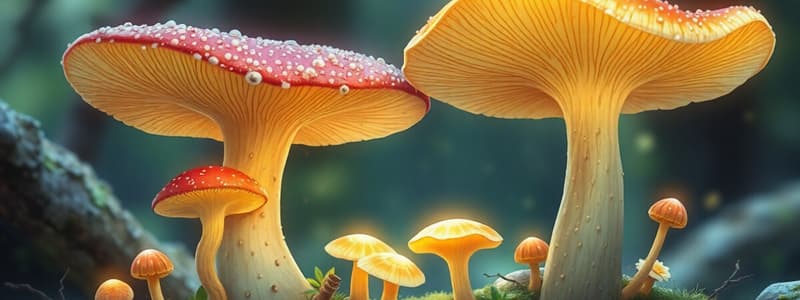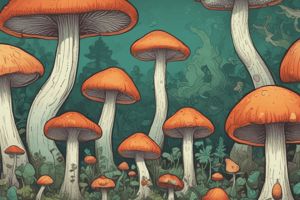Podcast
Questions and Answers
What is the primary role of dermatophytes?
What is the primary role of dermatophytes?
- To penetrate the roots of plants
- To aid in photosynthesis
- To cause disease in living organisms
- To recycle dead plant and animal material (correct)
Which type of fungi is primarily associated with mycorrhiza?
Which type of fungi is primarily associated with mycorrhiza?
- Penicillium
- Aspergillus (correct)
- Rhizopus
- Trichophyton
Which of the following options correctly defines parasitic fungi?
Which of the following options correctly defines parasitic fungi?
- Fungi that symbiotically assist plant growth
- Fungi that invade living organisms for nourishment (correct)
- Fungi that primarily exist as molds
- Fungi that recycle organic material
What distinguishes yeasts from molds?
What distinguishes yeasts from molds?
How do mycorrhiza fungi benefit plants?
How do mycorrhiza fungi benefit plants?
What is the significance of conidiospores in fungi?
What is the significance of conidiospores in fungi?
Which is a characteristic feature of imperfect fungi (Deuteromycetes)?
Which is a characteristic feature of imperfect fungi (Deuteromycetes)?
Among the following options, which is a method used for laboratory identification of fungi?
Among the following options, which is a method used for laboratory identification of fungi?
What best describes the growth form of molds?
What best describes the growth form of molds?
What is the characteristic morphological form of molds?
What is the characteristic morphological form of molds?
At what temperature do molds typically grow optimally?
At what temperature do molds typically grow optimally?
How do dimorphic fungi typically change form?
How do dimorphic fungi typically change form?
What form do thermally dimorphic fungi take at 37°C?
What form do thermally dimorphic fungi take at 37°C?
For how long should fungal cultures typically be incubated?
For how long should fungal cultures typically be incubated?
What is the incubation temperature standard for fungal cultures?
What is the incubation temperature standard for fungal cultures?
Which type of fungi is known to typically grow at body temperature?
Which type of fungi is known to typically grow at body temperature?
What is the main feature distinguishing molds from yeasts?
What is the main feature distinguishing molds from yeasts?
What is a common environmental condition necessary for fungal culture incubation?
What is a common environmental condition necessary for fungal culture incubation?
What type of reproduction can molds undergo?
What type of reproduction can molds undergo?
Which genus of dermatophyte is capable of invading hair, skin, and nails?
Which genus of dermatophyte is capable of invading hair, skin, and nails?
What is a characteristic feature of dermatophyte infections regarding temperature?
What is a characteristic feature of dermatophyte infections regarding temperature?
Which dermatophyte genus is involved with the skin and nails but not hair?
Which dermatophyte genus is involved with the skin and nails but not hair?
Which of the following dermatophyte genera is NOT associated with nail infections?
Which of the following dermatophyte genera is NOT associated with nail infections?
What type of enzymes do dermatophytes secrete to digest keratin?
What type of enzymes do dermatophytes secrete to digest keratin?
What is the shape of spores produced by Trichophyton?
What is the shape of spores produced by Trichophyton?
What characterizes nonseptate hyphae?
What characterizes nonseptate hyphae?
What is the function of rhizoids in fungi?
What is the function of rhizoids in fungi?
What is the role of the columella in fungal structures?
What is the role of the columella in fungal structures?
Which statement best describes a sporangiophore?
Which statement best describes a sporangiophore?
What is found inside a sporangium?
What is found inside a sporangium?
What type of hyphae contains septa?
What type of hyphae contains septa?
What feature allows the flow of cytoplasm in septate hyphae?
What feature allows the flow of cytoplasm in septate hyphae?
How do sporangiophores contribute to reproduction?
How do sporangiophores contribute to reproduction?
Where are sporangiospores primarily located?
Where are sporangiospores primarily located?
Which component is responsible for nutrient storage within fungal structures?
Which component is responsible for nutrient storage within fungal structures?
Which of the following species of Zygomycetes is characterized by having nodal rhizoids?
Which of the following species of Zygomycetes is characterized by having nodal rhizoids?
What type of hyphae lacks septa and cell membranes between the cells?
What type of hyphae lacks septa and cell membranes between the cells?
Which species of Zygomycetes are specifically noted as nonseptate?
Which species of Zygomycetes are specifically noted as nonseptate?
How do the rhizoids of Absidia species differ from those of Rhizopus?
How do the rhizoids of Absidia species differ from those of Rhizopus?
What characteristic is used to define hyaline hyphae?
What characteristic is used to define hyaline hyphae?
Which statement is true regarding the structure of nonseptate hyphae?
Which statement is true regarding the structure of nonseptate hyphae?
Which type of hyphae is often described as highly refractile?
Which type of hyphae is often described as highly refractile?
What is an example of a fungal structure embedded in bread?
What is an example of a fungal structure embedded in bread?
Which of the following is not a species of Zygomycetes mentioned?
Which of the following is not a species of Zygomycetes mentioned?
Which group of hyphae can be identified with the presence of septa at branching points?
Which group of hyphae can be identified with the presence of septa at branching points?
Study Notes
Mycology
- Mycology is the study of fungi.
- Fungi can be in the form of molds or yeasts.
Fungi Characteristics
- Molds are multicellular, filamentous, and branching.
- Molds grow at room temperature.
Dimorphism vs Monomorphism
- Dimorphic fungi can exist as both mold and yeast.
- Temperature change can trigger the conversion between mold and yeast forms.
- Yeast form grows at 37°C.
- Mold form grows at room temperature.
Fungal Cultures
- Optimum temperature for saprophytes (molds) is 20-30°C.
- Optimum temperature for parasitic fungi (yeast) is 30-37°C.
- Standard incubation temperature for fungi is 30°C.
- Fungal cultures require a humidified environment for 21 days.
Fungal vs. Bacterial Cultures
- Fungal Cultures:
- Nonseptate hyphae or Coenocytic have a smooth appearance.
- Rhizoids are root-like structures.
- Sporangium is a sac-like structure.
- Sporangiospores are spores within the sporangium.
- Bacterial Cultures:
- Septate hyphae possess dividers between cells called septa.
- The septa contain pores allowing cytoplasm and nutrient flow.
- Nonseptate hyphae or Coenocytic lack septa and cell membranes.
Zygomycetes
- Zygomycetes are nonseptate fungi.
- Important Zygomycetes species include:
- Rhizopus
- Mucor
- Absidia
Hyaline and Dematiaceous Hyphae
- Hyaline Hyphae are colorless and highly refractile.
- They secrete enzymes keratinase, digesting keratin in superficial structures only.
- Hyaline hyphae cannot grow at 37°C, thus no deep infections occur.
Dermatophytes
- Dermatophytes are a genus of fungi that infect keratinized structures.
- Three important genera include:
- Microsporum: Infects only hair and skin.
- Trichophyton: Infects hair, skin, and nails.
- Epidermophyton: Infects only skin and nails.
- Trichophyton: Has a pencil-shaped appearance.
Studying That Suits You
Use AI to generate personalized quizzes and flashcards to suit your learning preferences.
Related Documents
Description
This quiz covers the fundamental concepts of mycology, focusing on the characteristics and differentiation between molds and yeasts. It also includes the factors influencing fungal growth, including temperature and humidity, and contrasts fungal and bacterial cultures.



